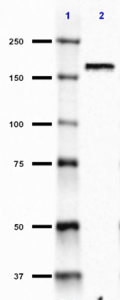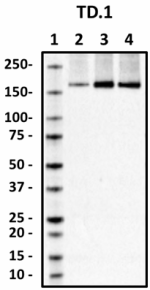- Clone
- TD.1 (See other available formats)
- Regulatory Status
- RUO
- Other Names
- Clathrin heavy chain 1, clathrin, heavy polypeptide-like 2, clathrin heavy chain on chromosome 17
- Previously
-
Covance Catalog# MMS-427P
- Isotype
- Mouse IgG1, κ
- Ave. Rating
- Submit a Review
- Product Citations
- publications

-

Western blot of purified anti-Clathrin Heavy Chain (CLTCL2) antibody (clone TD.1). Lane 1: Molecular weight marker; Lane 2: 20 µg of HeLa cell lysate. The blot was incubated with 5 µg/mL of the primary antibody overnight at 4°C, followed by incubation with HRP labeled goat anti-mouse IgG (Cat. No. 405306). Enhanced chemiluminescence was used as the detection system. -

Western blot of purified anti-Clathrin Heavy Chain (CLTCL2) antibody (clone TD.1). Lane 1: Molecular weight marker; Lane 2: 20 µg of Drosophila S2 (embryonic) cell lysate. The blot was incubated with 1 µg/mL of the primary antibody overnight at 4°C, followed by incubation with HRP-labeled goat anti-mouse IgG (Cat. No. 436302). Enhanced chemiluminescence was used as the detection system. -

ICC staining of purified anti-Clathrin Heavy Chain (CLTCL2) antibody (clone TD.1) on Drosophila S2 cells. The cells were fixed with 4% PFA, permeabilized with a buffer containing 0.1% Triton X-100 and 0.25% BSA, and blocked with 2% normal goat serum and 0.02% BSA. The cells were then incubated with 1 µg/ml of the primary antibody for overnight at 4°C, followed by incubation with 2.5 µg/ml of Alexa Fluor® 647 goat anti-mouse IgG (Cat. No. 405322) for one hour at room temperature. Nuclei were counterstained with DAPI. The image was captured with a 60X objective. Scale bar: 10 µm
Clathrin consists of three heavy chains (192 kD) and three light chains (LCa or LCb, 25-29 kD) and self assembles into a polyhedral cytoskeletal element. The self assembly facilitates clathrin's central role in membrane sorting and selective transport within the cell.
Product DetailsProduct Details
- Verified Reactivity
- Human, Drosophila
- Antibody Type
- Monoclonal
- Host Species
- Mouse
- Immunogen
- This monoclonal antibody was raised using the globular N-terminal domain of clathrin heavy chain.
- Formulation
- Phosphate-buffered solution + 0.03% Thimerosal.
- Preparation
- The antibody was purified by affinity chromatography.
- Concentration
- 1 mg/mL
- Storage & Handling
- The antibody solution should be stored undiluted between 2°C and 8°C. Please note the storage condition for this antibody has been changed from -20°C to between 2°C and 8°C. You can also check your vial or your CoA to find the most accurate storage condition for this antibody.
- Application
-
WB - Quality tested
ICC - Verified - Recommended Usage
-
Each lot of this antibody is quality control tested by Western blotting. For Western blotting, the suggested use of this reagent is 1.0 - 10 µg per mL. For immunocytochemistry, a concentration range of 1.0 - 5.0 μg/mL is recommended. It is recommended that the reagent be titrated for optimal performance for each application.
- Application Notes
-
This antibody reacts with clathrin heavy chains (CHC). The antibody is useful for immunoblotting of clathrin heavy chains from cow CHC and immunofluorescence. It does not react with native clathrin in immunoprecipitation.
Reactivity to Drosophila was only verified with the purified format. - Additional Product Notes
-
For Western blotting, the suggested use of this reagent is 5 -10 µg/ml in human, mouse, and rat and 1-10 µg/ml in Drosophila.
-
Application References
(PubMed link indicates BioLegend citation) -
- Hood FE and Royle SJ. 2009. J Cell Sci. 122:2185-2190. (ICC) PubMed
- Jiang R, et al. 2000. J Biol Chem 275(12):8439-8447. (IP)
- Product Citations
-
- RRID
-
AB_2564779 (BioLegend Cat. No. 813901)
Antigen Details
- Biology Area
- Cell Biology, Neurodegeneration, Neuroscience, Protein Trafficking and Clearance
- Gene ID
- 1213 View all products for this Gene ID
- UniProt
- View information about Clathrin Heavy Chain on UniProt.org
Related Pages & Pathways
Pages
Related FAQs
Other Formats
View All Clathrin Heavy Chain (CLTC) Reagents Request Custom Conjugation| Description | Clone | Applications |
|---|---|---|
| Purified anti-Clathrin Heavy Chain (CLTCL2) | TD.1 | WB,ICC |
| HRP anti-Clathrin Heavy Chain (CLTCL2) | TD.1 | WB |
Compare Data Across All Formats
This data display is provided for general comparisons between formats.
Your actual data may vary due to variations in samples, target cells, instruments and their settings, staining conditions, and other factors.
If you need assistance with selecting the best format contact our expert technical support team.
-
Purified anti-Clathrin Heavy Chain (CLTCL2)

Western blot of purified anti-Clathrin Heavy Chain (CLTCL2) ... 
Western blot of purified anti-Clathrin Heavy Chain (CLTCL2) ... 
ICC staining of purified anti-Clathrin Heavy Chain (CLTCL2) ... -
HRP anti-Clathrin Heavy Chain (CLTCL2)

Western blot of HRP anti-Clathrin Heavy Chain (CLTCL2) antib...







Follow Us